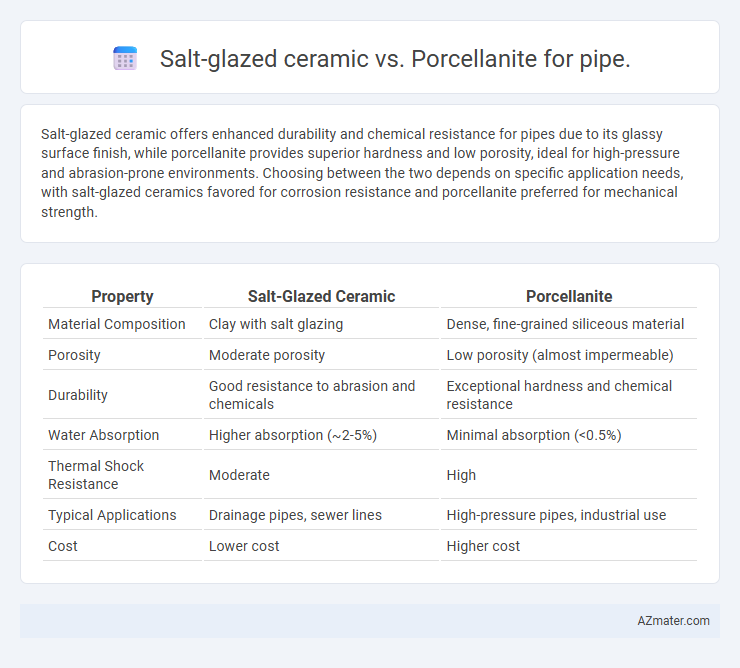Salt-glazed ceramic offers enhanced durability and chemical resistance for pipes due to its glassy surface finish, while porcellanite provides superior hardness and low porosity, ideal for high-pressure and abrasion-prone environments. Choosing between the two depends on specific application needs, with salt-glazed ceramics favored for corrosion resistance and porcellanite preferred for mechanical strength.
Table of Comparison
| Property | Salt-Glazed Ceramic | Porcellanite |
|---|---|---|
| Material Composition | Clay with salt glazing | Dense, fine-grained siliceous material |
| Porosity | Moderate porosity | Low porosity (almost impermeable) |
| Durability | Good resistance to abrasion and chemicals | Exceptional hardness and chemical resistance |
| Water Absorption | Higher absorption (~2-5%) | Minimal absorption (<0.5%) |
| Thermal Shock Resistance | Moderate | High |
| Typical Applications | Drainage pipes, sewer lines | High-pressure pipes, industrial use |
| Cost | Lower cost | Higher cost |
Introduction to Pipe Materials: Salt-Glazed Ceramic vs Porcellanite
Salt-glazed ceramic pipes feature a durable, glossy surface created by firing common clays with salt, resulting in enhanced water resistance and chemical durability ideal for sewage systems. Porcellanite pipes, made from a dense, vitrified ceramic material, offer superior strength and low porosity, making them highly resistant to abrasion and suitable for high-pressure applications. Both materials provide effective corrosion resistance, but porcellanite generally outperforms salt-glazed ceramics in mechanical strength and longevity under demanding conditions.
Material Composition: Understanding the Basics
Salt-glazed ceramic pipes feature a silica-based clay body with a sodium salt glaze that creates a glassy, textured surface during firing, enhancing durability and resistance to corrosion. Porcellanite pipes are composed primarily of a dense, fine-grained ceramic mixture with high kaolin content, resulting in a smooth, non-porous surface that offers superior impermeability and mechanical strength. Understanding these material compositions is crucial for selecting the appropriate pipe type based on environmental exposure and load-bearing requirements.
Manufacturing Process Comparison
Salt-glazed ceramic pipes undergo a manufacturing process where sodium salt is introduced into the kiln at high temperatures, creating a distinctive glassy, textured surface through a chemical reaction with the clay body. Porcellanite pipes, on the other hand, are produced by sintering highly refined kaolin clay at even higher temperatures to achieve a dense, vitrified, and non-porous structure with superior strength. The salt glazing process adds a protective, waterproof layer ideal for corrosion resistance, whereas porcellanite relies on intrinsic material properties for durability and low permeability.
Mechanical Strength and Durability
Salt-glazed ceramic pipes exhibit high mechanical strength due to their vitrified surface, providing excellent resistance to abrasion and impact, enhancing their durability in harsh environments. Porcellanite pipes offer superior mechanical strength with dense, non-porous material composition, resulting in exceptional durability and resistance to chemical corrosion and structural deformation. Both materials are favored in industrial piping for their long-lasting performance, though Porcellanite typically outperforms salt-glazed ceramic in maintaining integrity under extreme mechanical stress.
Chemical Resistance and Corrosion Performance
Salt-glazed ceramics exhibit excellent chemical resistance due to their dense, glassy surface formed by salt vapor during firing, making them highly effective against acidic and alkaline environments commonly encountered in piping applications. Porcellanite, a dense, siliceous rock with inherent hardness and chemical inertness, offers superior corrosion resistance, particularly against aggressive industrial chemicals and high-temperature fluids. Both materials provide durable solutions for pipe corrosion; however, porcellanite's natural mineral composition often results in enhanced longevity under extreme chemical exposure compared to the synthetic glaze of salt-glazed ceramics.
Installation and Handling Differences
Salt-glazed ceramic pipes exhibit increased surface roughness, requiring careful alignment during installation to prevent leakage and ensuring proper mortar bonding due to their porous texture. In contrast, porcellanite pipes offer a smoother, harder surface that simplifies handling and connection, enabling quicker installation with mechanical joints and reduced risk of abrasion damage. The heavier weight of salt-glazed ceramics demands more manpower or machinery, whereas porcellanite's high density but compact design facilitates easier transportation and placement on-site.
Lifespan and Maintenance Requirements
Salt-glazed ceramic pipes offer a durable surface resistant to chemical corrosion and abrasion, typically lasting 50-70 years with minimal maintenance due to their glazed finish preventing buildup. Porcellanite pipes, composed of dense, vitrified clay or similar materials, provide enhanced mechanical strength and an even longer lifespan of up to 80 years, but require periodic inspection to prevent cracking and maintain structural integrity. Maintenance for salt-glazed ceramic is low, primarily limited to surface cleaning, while porcellanite demands regular checks for impact damage and potential spalling to ensure optimal performance.
Cost Analysis: Initial and Long-term Investment
Salt-glazed ceramic pipes typically have a lower initial cost compared to Porcellanite, making them a budget-friendly option for projects with tight upfront budgets. However, Porcellanite offers superior durability and resistance to chemical corrosion, which translates into lower maintenance and replacement expenses over the pipe's lifespan. Considering the total cost of ownership, Porcellanite often presents a more economical investment for long-term infrastructure due to reduced downtime and extended service life.
Environmental Impact and Sustainability
Salt-glazed ceramic pipes exhibit lower environmental impact due to their use of natural clay and salt, which results in less energy-intensive firing processes and minimal chemical additives. Porcellanite, being a dense, hard sedimentary rock, requires extensive quarrying and energy-consuming processing, contributing to higher carbon emissions and habitat disruption. Sustainable pipeline construction favors salt-glazed ceramic for its recyclability and biodegradability compared to the non-renewable, non-biodegradable nature of porcellanite-based materials.
Choosing the Right Material: Application-Specific Recommendations
Salt-glazed ceramic pipes excel in corrosion resistance and durability, making them ideal for sewer systems and drainage applications exposed to acidic waste. Porcellanite offers superior strength and impermeability, suited for high-pressure water supply and industrial fluid transport where mechanical stress is significant. Selecting between these materials depends on specific needs such as chemical exposure, load-bearing capacity, and environmental conditions to ensure optimal pipe performance and longevity.

Infographic: Salt-glazed ceramic vs Porcellanite for Pipe
 azmater.com
azmater.com